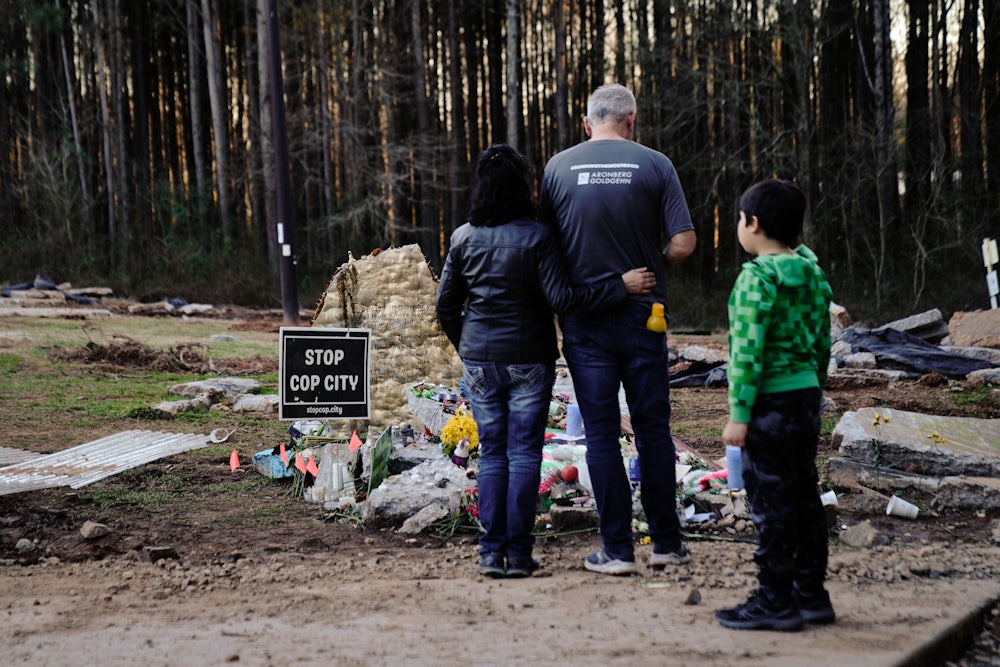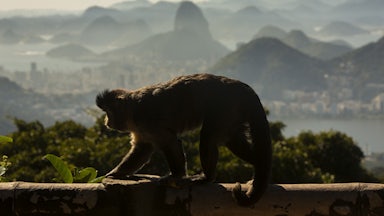Twenty-three more protesters were charged with domestic terrorism this week in the ongoing controversy over “Cop City,” the site of Atlanta’s proposed 381-acre police training center in the Weelaunee Forest. The project, situated in a lush watershed surrounded by a largely Black neighborhood, is supported by the private Atlanta Police Foundation, which is backed by many of the usual right-wing funders, including Home Depot and the Koch brothers. And in the past few months, it has become a powerful symbol of how Black Americans are brutally surveilled and policed while also deprived of such public goods as green space and clean air.
The news stories seem to focus on the supposed violence of protesters, who have allegedly been burning cars and throwing some Molotov cocktails and rocks. Yet the police are the only ones who have killed anyone during the course of this conflict, which has been brewing since the plans for Cop City were first announced in 2017. In January, police killed 26-year-old demonstrator Manuel Esteban Paez Terán, in highly dubious circumstances. While police claim the protester shot first, body cam footage subsequently released seems to suggest that the state trooper allegedly struck by Terán was in fact shot by other officers. A private autopsy has also shown that Terán was shot at least 13 times.
While there are many examples of state-sponsored murder of environmental activists around the world, Terán’s killing is unprecedented in the United States. State violence against the forest defenders continues: The protesters arrested this weekend and charged with “domestic terrorism” could face prison sentences of up to 35 years. (Other activists arrested in the forest over the last few months are being prosecuted with similarly horrifying zeal.)
Yet the sense of the urgency of saving the forest, reflected in the protesters’ disruptive tactics, is one that all Americans should share. Urban forests must be defended because they benefit all of us.
Forests and trees are so good for human psychological well-being that a Japanese concept known as “forest bathing” (shinrin-yoku)—immersing oneself in forest in order to feel better—has become trendy here, even endorsed by Hillary Clinton, hardly a person prone to hippy enthusiasms. We hear a lot about the mental health crisis in this country, especially among young people, but not enough about the research showing how much access to green space can help. Parks and trees also boost city-dwellers’ physical health. The psychological and physiological benefits of shinrin-yoku have been established by several Japanese studies, one of which found it particularly healing for people with depressive tendencies. Since four out of five Americans live in a city, then, our collective well-being clearly demands urban forests like the Weelaunee.
I am biased here, as an enjoyer of the urban forest. I explored the Bronx River Forest this summer, finding the cool greenery well worth the long subway ride from Brooklyn and the surprising—in our thoroughly mapped and GPS’ed world—dearth of internet instruction or physical signage guiding one there. To say that expeditions like this boost well-being would be an understatement; if you enjoy the outdoors, a journey to a forest entails an overwhelming joy at being alive. We hygienically reduce such joy to “mental health” as if to justify it.
There weren’t many other New Yorkers “forest-bathing” in the Bronx that day I visited in the summer; as in Atlanta, increased fears of urban violence can shape perceptions of our forests, which is probably why an acquaintance who works for the New York City Parks Department warned me not to go alone. Cities are home to millions of inhabitants who prefer to avoid forests, whether due to fears of crime or anxiety about nature itself.
But even people who don’t visit the urban forests still benefit from them. Trees trap air pollutants that would otherwise damage our lungs. The Georgia Forestry Commission, a state agency, notes that forests in Atlanta remove about 19 million pounds of pollutants from the air every year.
Forests also help to allay and mitigate the effects of climate change. Trees produce oxygen and suck carbon dioxide out of the atmosphere. Cities—despite their overall climate benefits due to housing density and less car use—can act as heat islands, trapping heat and altering weather patterns. But urban forests can alleviate those problems, as studies of urban green space are starting to show. One study published last December found urban parks in and around Kolkata, India, had a “substantial” cooling effect on nearby areas, with the extent of that effect “largely determined by the greenness of the parks.” And Retiro Park in Madrid, for instance—which, though not formally a forest, contains a lot of trees—has been found to cool areas about 430 feet away from the park’s edge by nearly three degrees, and areas over 900 feet away by over a degree and a half.
Trees also filter water, which can protect us from flooding as well as from the erosion that often results from storms. According to one 2015 study calculating trees’ potential effect in Ljubljana, Slovenia, some cities could save thousands each year in stormwater-runoff reduction simply by planting more trees.
While Atlanta may be unique in attempting to sabotage its forest with a massive, militarized police headquarters, the Weelaunee Forest is not the only urban forest urgently needing protection. Paradoxically, although we need urban forests to ease climate change and protect us from its effects, in most places the biggest threat to these forests is climate change; urban trees are particularly vulnerable to subtle changes in climate because their ecological support network of soil and fellow trees and plants is not as extensive as that enjoyed by trees in the wilderness.
Many environmental activists are currently pushing to expand urban forests, as a matter of ecological equity. The pleasures of nature should not be hogged by billionaires who can afford homes in Jackson Hole, nor should those most responsible for pollution and climate change be the only ones with access to clean air and a livable climate. Cities like New York City, Detroit, and Grand Rapids are working to protect and expand their urban forests. Last year, the city of Detroit worked with private groups to create the five-year, $30 billion Detroit Tree Equity Partnership, to plant at least 75,000 more trees, employ hundreds of Detroiters in tree care and maintenance work, and create a healthy tree canopy around a city whose name is hardly synonymous with the bucolic. Increasingly, valuing the urban forest is not even radical—respectable nonprofits like the Nature Conservancy have been enthusiastically supporting these worthy efforts.
But in Atlanta, defending the urban forest requires enormous personal sacrifices. Forest defenders are losing their freedom and even their lives. Those people are heroes, but they shouldn’t be treated this way, and they shouldn’t be standing alone: The forest should be a mainstream cause embraced by all Americans. Our cities and our lives depend on our willingness to fight for such spaces.










